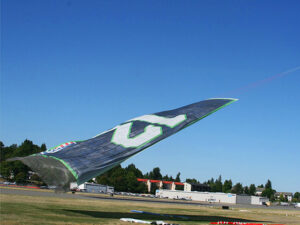January 15, 2010
Have you ever been at a large gathering somewhere, like a sporting event or a beach, and seen an airplane fly by pulling an announcement or an advertisement of some type? These ads or messages are called airplane banners, and have proven to be an effective way to get a message out to a large group quickly.
So how do we get such a huge banner into the sky? If the banner were attached to the plane before it took off, this would cause two problems. First, the banner would drag across the runway and get damaged. Second, The drag of the huge banner would make it more difficult to get off the ground and this means the banner would drag even longer.
Getting the airplane banner into the sky takes a great deal of skill. But the huge success of aerial advertising makes it worth the trouble. First, the airplane takes off with a device called a “grapnel hook” hanging in the window. The other end is attached to the tail of the airplane by either rope or cable.
When the airplane is safely off the ground, the pilot unhooks the device from the window, letting it trail behind the plane. On the ground the banner or billboard is folded up with a lead pole in front. A harness is attached to the lead pole. Then a pick up rope is attached to a loop of rope that is attached between two poles about five or six feet off the ground.

Now the plane circles around and, with the hook dragging below the plane and flying at 80 miles an hour, the pilot heads straight for the two poles. As he reaches them, he throttles the engine and pulls back on the stick, causing the plane to soar upward at a steep angle. The hook snags the loop of rope, which pulls the banner up, off the ground and into the sky. What if he misses? Then he circles around and tries it again.
But how does the banner stay upright and not, like a kite, spiraling in the wind? First, the tail end of heavy billboards or banners has tiny parachutes that catch the wind and keep it straight. Then the bottom has weights that keep that edge closest to the ground. The letters are usually seven feet tall and the banner might be up to fifty letters long. So everything must be planned just right so that the drag is not too great or too little.
When our pilot has completed his mission over the designated area, he will fly the banner back to the drop off place, fly low again, and, release the hook so the banner falls to the ground unharmed. This way it is reusable if that is desired.
All this may seem like a lot of trouble, but the result is worth the effort. Thousands will see the banner, both at the event and on the way to and from it. The message will get out and people will be influenced by the message. But not all aerial advertising is provided equally. Some companies simply take an order and contract it out. Since 1996, AirSign has been leaders in the industry by taking personal care of their customers using the best pilots, sharpest looking planes, and providing accountability for their work through free GPS tracking. Give us a call at (888) 645-3442 and find out what we can do for you!
